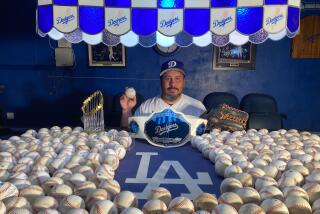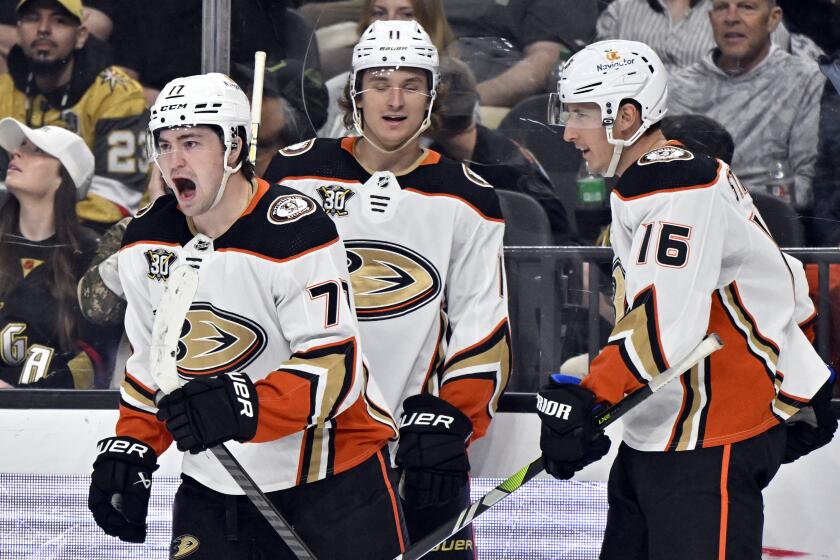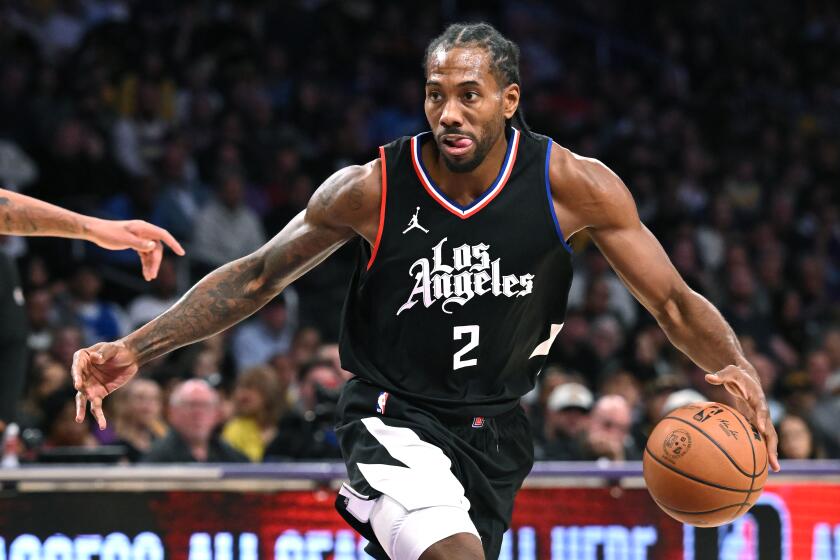A Cycle of Success
The name Valentino Rossi sounds more like that of an opera singer than a motorcycle racer, but it is fitting because the fun-loving Italian is a virtuoso.
On two wheels.
Kenny Roberts, Eddie Lawson and Wayne Rainey, three Californians in the Motorcycle Hall of Fame with 10 world road racing championships among them, all say there has never been anyone better -- maybe as good, but none better.
Henny Ray Abrams, an international racing authority, wrote, “Valentino Rossi is the greatest motorcycle racer ever,” in the magazine Sport Rider.
And that was before Rossi, who lives in London and rides for Yamaha, grabbed the 2005 MotoGP season by the throat and held it hostage by winning six of the first seven races.
Although only 26, Rossi has won six world championships -- the last four in a row in the sport’s premier class. Three times he won on a Honda and last year on a Yamaha. He has never raced in the United States, but that gap in his resume will be closed this week when he rides in the Red Bull U.S. Grand Prix on the Mazda Raceway Laguna Seca’s hillside course.
“I am happy come to California. I have never been there but I know is very beautiful for the sun, the beautiful girls,” the heavily accented Rossi said by telephone from Assen, Holland, where last Sunday he won the Gauloises Dutch TT, race No. 7 in the 17-race MotoGP season.
“I know Laguna Seca only from TV,” he said, then added mischievously, “and from my PlayStation. I know the layout. I have studied it many times. Colin [Edwards, a teammate] is very fast on PlayStation. We have some tough fights together.
“I think the track is very difficult because it goes up and down a lot and I think it is quite technical. Very difficult will be the first left after the straight and the Corkscrew, where there is change of direction and very much downhill.”
Combining rare talent with an exuberance that endears him to fans, Rossi is a cult figure in Europe and Asia, where 200-mph motorcycle racing is as popular as Formula One, and sometimes more so. Two races in Spain last year, one in the rain, drew more than 200,000 spectators, and seven others attracted crowds of more than 100,000.
The three-day event in Monterey will be the first world road racing championship held in the United States since 1994 at Laguna Seca.
“Riding Laguna Seca sitting at a PlayStation may help him learn the layout and even the speed changes, but no electronic game can give you the feeling of the bumps and the acceleration you get on the track,” warned Rainey, a three-time winner at Laguna Seca to go with his three world championships.
Rossi gained his reputation as a riding phenomenon when he became the youngest world 125cc champion in 1997 at 18, riding an Aprilia. Two years later, he won the 250cc title, once again with Aprilia. In 2000 he joined Honda and after finishing second in his first 500cc season, the next year he won 11 races on his way to the championship in what was the last of the two-stroke era. He was only 22.
When the FIM, motorcycle racing’s international governing body, mandated four-stroke bikes in 2002 for the newly named MotoGP series, Rossi continued his success with another 11 wins and another championship.
The move that stunned the racing industry and gave Rossi an air of invincibility came after the 2003 season when he had won his third championship with all-conquering Honda, only to announce that he was defecting to a struggling Yamaha team.
“That switch took some [guts],” said three-time champion Roberts. “That’s what makes him so good, he can take something not competitive, make it competitive and win on it. Yamaha would have made a good bike, but not good enough to win unless it had Valentino on it.”
The move had a reverse effect on Honda.
Although Rossi says he switched because he wanted a new challenge, those close to him insist that he was nettled by Honda’s attitude that the team’s success was due to the bike, not the rider, and that another rider, given Rossi’s bike, could win.
It didn’t happen. In the first race of 2004, Rossi and the revamped Yamaha finished in front, followed by the Hondas of Max Biaggi, Sete Gibernau and Alex Barros.
“It was a miracle,” Rossi said on the podium in South Africa.
After eight more wins, he brought the championship to Yamaha.
The switch from Honda was similar to the move by supercross champion Ricky Carmichael, who moved to Suzuki last year after he felt unappreciated at Honda despite winning three national titles. He immediately won with his new bike.
“Valentino Rossi is more than the world’s best motorcycle racer, he is a personality that is not limited to the confines of the MotoGP championship,” said Toru Hasegawa, the Yamaha company’s president, at the 2004 team victory banquet. “From the moment you work with him, you instantly become a fan. Because of this personality I am proud to present Valentino with the YZR-M1 he rode to his sixth world title.”
Rossi responded, “This is the best gift I could wish for. I am not sure where I will keep it, maybe next to my bed, or maybe in a safe at a bank.”
His win placed Rossi in an elite group with Lawson, Italy’s Giacomo Agostini and Britain’s Mike Hailwood as riders who have won four or more titles in cycling’s most prestigious class.
When Rossi made the Honda to Yamaha move, he brought along his crew chief, Jeremy Burgess, and most of his crew.
“Jeremy Burgess is very important, I like especially the way he works,” Rossi said. “He is always very quiet when things go OK and also quiet when we have a problem. So it is important to me ... to bring him with me to Yamaha. For sure, it was great idea.”
Known as the “Doctor” because of his stature in the sport, the 5-foot-10, 130-pound second-generation rider exploits his nickname with a pixieish sense of humor. On the victory podium, he sometimes wears a white doctor’s smock and once showed up wearing a graduation cap with his sponsor’s name on it.
Superstitious, he also has a pre-race ritual in which before mounting his bike he kneels and grabs his foot peg in a loving manner, and he also tugs on his earring before pulling on his helmet.
As with most champions, his success does not come without controversy. In this year’s season opener in Jerez, Spain, Rossi won with a dramatic last-lap, last-turn pass of Gibernau, who claimed that Rossi had unfairly cut him off. The contact sent Gibernau off into the sand pit as Rossi rode to the finish line.
Francesco Zerbi, president of the FIM, wrote Rossi, warning him about future rough riding incidents.
“It say everyone want to win and everyone try very hard for arrive at the victory,” Rossi said of the letter. “And he say that the overtake was hard but not over the limit. He say don’t make it worse.
“But if I have the same space in the last corner of the next race, I make the same move.”
It is that aggressive attitude that makes him a superstar, says Roberts, who also fields his own team in the MotoGP series.
“He loves it, he tests more, he rides more, he rides faster and he’s not afraid to take a chance,” Roberts said. “He is the complete package. Talent-wise, he is the best. Among the all-time greats, he is right there.”
Roberts says it is difficult to compare Rossi to champions from earlier eras.
“We rode two-strokes, and Valentino won on them too, but today’s four-stroke is so much faster and so much easier to ride there’s no way to know. In this era, though, he is the guy. No doubt,” he said. “He not only loves to ride, he’s a student of the game. He knows the other riders’ style, their strong points and their weaknesses, and he knows how to exploit them. The biggest difference is that he truly loves what he is doing.”
Rossi acknowledges he put extra pressure on himself after taking on the Yamaha challenge.
“Last year, for sure everyone expect me not to win the championship,” he said. “But after some races, there was some pressure because we were able to fight for the championship. For sure, this year we start from the number one and the pressure is more. But more or less it is every race, and every year, about the pressure.
“The important thing is to work, stay quiet, work well with the bike and try to ride the bike to find the good setting.”
One pattern in his winning is the ability to come from behind. Rossi often lags back in the early stages of a race and rallies at the last minute.
“It’s almost as if he is stalking the leaders,” said John Hopkins, a Californian who rides a Suzuki in the series.
Rainey, who was instrumental in bringing MotoGP back to Laguna Seca, says he believes that Rossi’s biggest weapon is intimidation.
“If you watch Valentino real close, he makes mistakes, but the other guys don’t capitalize on them,” Rainey said. “They act like they know he’ll be coming when it counts. He’s done it to them so many times it’s like they think it is inevitable.”
Race charts prove his point. At Assen, Rossi ran the fastest lap of the race on the final one to beat Honda rider Marco Melandri.
After practice Friday and qualifying Sunday on the 2.238-mile, 11-turn road course that is the smallest in MotoGP, Rossi will have 32 laps to display his precocious talent. The race is sold out, with a crowd of more than 65,000 expected.
*
(BEGIN TEXT OF INFOBOX)
Unstoppable
Valentino Rossi, 26, has won the last four MotoGP world championships and is the points leader entering this week’s race at Laguna Seca.
*--* Rider Country Points Valentino Rossi Italy 170 Marco Melandri Italy 107 Max Biaggi Italy 87 Sete Gibernau Spain 84 Alex Barros Brazil 74 Colin Edwards U.S. 73 Nicky Hayden U.S. 60 Loris Capirossi Italy 49 Shinya Nakano Japan 48 Carlos Checa Spain 40
*--*
More to Read
Get our high school sports newsletter
Prep Rally is devoted to the SoCal high school sports experience, bringing you scores, stories and a behind-the-scenes look at what makes prep sports so popular.
You may occasionally receive promotional content from the Los Angeles Times.






